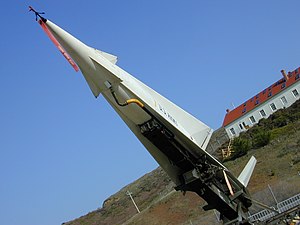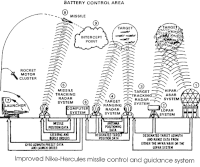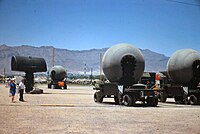Nike Hercules
| MIM-14 Nike-Hercules | |
|---|---|
 Nike-Hercules Missile | |
| Type | Surface-to-air missile |
| Production history | |
| Manufacturer | Western Electric, Bell Laboratories, Douglas Aircraft Company |
| Specifications | |
| Mass | 29,000 pounds (13,000 kg) |
| Length | 41 feet (12 m) overall 26 feet 10 inches (8.18 m) second stage |
| Diameter | booster 31.5 inches (800 mm) second stage 21 inches (530 mm) |
| Wingspan | 11 feet 6 inches (3.51 m) booster 6 feet 2 inches (1.88 m) second stage |
| Warhead | initially W7 (2.5 or 28 KT)[1][verification needed] later W31 nuclear 2 kt (M-97) or 20 kt (M-22)[2] or T-45 HE warhead weighing 1,106 pounds (502 kg) and containing 600 pounds (270 kg) of HBX-6 M17 blast-fragmentation |
| Engine | Booster: Hercules M42 solid-fueled rocket cluster (4x M5E1 Nike boosters) 978 kN (220000 lb) Sustainer: Thiokol M30 solid-fueled rocket 44.4 kN (10000 lb) |
Operational range | 90 miles (140 km) |
| Flight ceiling | 150,000 feet (46,000 m) |
| Maximum speed | >Mach 3.65 (ca. 2750 mph or 4,470 km/h) |
Nike-Hercules Missile, designation MIM-14 (initially SAM-N-25), was a solid fuel propelled two-stage surface-to-air missile, used by US and NATO armed forces for high- and medium-altitude air defense. It could also be employed in a surface-to-surface role.
Development and deployment
The Nike-Hercules system, a follow-up to the Nike-Ajax missile, was developed during the Cold War to destroy enemy bombers and enemy bomber formations, as well as serve as an anti-ballistic missile system. Western Electric, Bell Laboratories, and Douglas Aircraft Company were chief contractors for the system. Nuclear-armed Nike Hercules missiles were deployed in the United States, Greece, Italy, and Turkey, and with Belgian, Dutch, and U.S. forces in West Germany.[3] Conventionally-armed Nike Hercules missiles also served in the United States, Germany, Denmark, Japan, Norway, and Taiwan.[4] The first deployments in Europe began in 1959[5] and the last nuclear-armed Nike Hercules missiles in Europe were deactivated in 1988.[6] The Nike-Hercules missile systems sold to Japan (Nike J) were subsequently fitted with upgraded internal guidance systems, the original vacuum tube systems being replaced with transistorized ones.
Capabilities
The Nike Hercules could carry either a nuclear warhead or a conventional high explosive warhead (T-45 fragmentation type). Initially the nuclear-armed version carried the W-7 Mod 2E nuclear warhead, with yields of 2.5 or 28 KT. Beginning in FY 1961 the older warheads were replaced by W-31 Mod 0 warheads, with yields of 2 KT (Y1) or 30 KT (Y2).[7][verification needed] The last versions carried the W31 Mod 2 warhead, with yields of 2 or 20 KT.[8] The missile was 41 feet 6 inches (12.65 m) long with a wingspan of 6 feet 2 inches (1.88 m). 145 missile batteries were deployed during the cold war. The missile had a range of about 77 miles (124 km). Because of the missile's effectiveness against certain ICBMs, it was made a part of the SALT I treaty.
Guidance


The Nike Hercules was a guided missile controlled from a groundstation. The guidance and control area (Integrated Fire Control, IFC) was located at a distance (about 1 mile) from the area from where the missile was launched (Launching Area, LA). The IFC had a low power acquisition radar (LOPAR) to detect (enemy) aircraft. After detecting and identifying a hostile aircraft with the aid of a Identification friend or foe system, this aircraft was followed or tracked in elevation, azimuth and range by a Target Tracking Radar (TTR). An analog (later digital) computer computed continually a point in the sky where the missile and target should meet (intercept point) after a potential launch of the missile. After the missile was actual launched by the Battery Control Officer (BCO) a Missile Tracking Radar (MTR) tracked the missile and the computer constantly updated the intercept point even if the hostile aircraft performed evasive actions. Steering corrections were sent to the missile by the MTR. When the missile neared the intercept point a command signal was sent to the missile to explode. To measure the range to the target under jamming conditions the IFC was also equipped with a Target Ranging Radar (TRR). Some IFC’s were equipped with a high power acquisition radar (HIPAR) to augment the initial detecting range of hostile aircraft. For command and control the sites were linked with a digitally communication system (initial the AN/MSQ-18 system).
On the IFC the system was operated by a crew of about 9 operators under command of the BCO. Locking on to the target had to be done manually by varying the range, elevation and azimuth of the TTR. For this the LOPAR provided the rough initial azimuth and range. After a 'lock-on' the system could track the missile and target automatically However a manual tracking mode was available in case an automatic track could not be established. The firing of the missile was done manually by the BCO based on the rules of engagement. The crew on the LA, also under command of the BCO, was responsible for preparing and erecting the missile.
Soviet counterpart
The Nike Hercules and Nike Ajax was comparable to the Soviet SA-2 Guideline medium range missile, but few were fired in combat. The Soviet missile saw considerable use during the Vietnam War against US aircraft. Those missiles were quite effective against aircraft flying at moderate or high altitudes, and resulted in elaborate tactics to either fly under the effective minimum altitude, or use powerful and sophisticated jamming pods or dedicated electronic warfare aircraft.
Deactivation
When it became apparent that the greatest threat to US National defense was from missiles instead of bombers, most Nike-Hercules units were deactivated. All CONUS Nike-Hercules batteries, with the exception of the ones in Florida and Alaska, were deactivated by April 1974. The remaining units were deactivated during the spring of 1979. Dismantling of the sites in Florida - Alpha Battery in Everglades National Park, Bravo Battery in Key Largo, Charlie Battery in Carol City and Delta Battery, located on Krome Avenue on the outskirts of Miami - started in June 1979 and was completed by early fall of that year. The buildings that once housed Delta Battery became the original structures used for the Krome Avenue Detention Facility, a federal facility used primarily to hold illegal immigrants awaiting immigration hearings. In Alaska, Site Point was converted into a ski chalet for Kincaid Park.
The US Army continued to use Nike-Hercules as a front-line air defense weapon in Europe until 1983, when Patriot missile batteries were deployed. NATO units from West Germany, the Netherlands, Denmark, Belgium, Norway, Greece and Turkey continued to use the Nike-Hercules for high-altitude air defense until the late 1980s. With the collapse of communism in Eastern Europe, the units were deactivated.
Replacement
The Patriot missile replaced the Nike-Hercules Missile in the high- and medium-altitude air defense roles. Its advantage over the Nike-Hercules system was its mobility and reliability. While a Nike-Hercules site could take days to be established, Patriot sites can be established in hours. Patriot also uses a more advanced phased-array radar system and has better missile target tracking. Over the years, the non-solid state guidance system as well as the complex fire control systems' radars suffered from diminishing manufacturing source (DMS) issues. In part because of less parts supportability, Western European (4th Allied Tactical Air Force (ATAF) and 2 ATAF) sites essentially became fixed sites and were no longer considered capable of a mobile role. During the last years of their deployment in Europe the issue at hand was more about maintaining security of the nuclear capable missiles, rather than mobility. The DoD invested considerably in upgrading the security of the storage areas of the launcher sections, ultimately installing significant towers that were capable of watching over all three sections within the "exclusion area."
Preservation
In 2006, a missile that was being transported in South Korea burned in a tunnel. Many former Nike sites in the USA and abroad still exist though only a few have been preserved. One, SF-88L north of the Golden Gate, is being maintained as a part of the Golden Gate National Recreation Area, complete with an operating underground missile shelter, Cold War period-uniformed staff, RADAR guidance systems, and period vehicles and equipment. In the Malibu hills near Los Angeles, a former Nike Hercules site has been rented to the local fire department for use as a training facility. One of the underground missile sections remains accessible.
This article is missing information about section. (February 2009) |
Below is a list of museums which have a Nike-Hercules missile in their collection:
Europe
- Airforce Museum of the Bundeswehr, Kladow, Germany
- Militair Luchtvaart Museum (Military Aviation Museum), Soesterberg, Netherlands
- Etimesgut Air Force Museum, Ankara, Turkey
- National War Museum Athens, Greece
- Trøgstad Fort, Østfold, Norway
- The Gardermoen Aircraft Collection, Gardermoen, Norway
- Kristiansand Airport, Kjevik, Royal Norwegian Air Force training centre, Norway
- Rygge air force base, Norway
- Royal Museum of the Armed Forces and Military History, Brussels, Belgium Royal Museum
- Cold War Museum Stevnsfort, Denmark Stevnsfortet
North America
- Air Force Space & Missile Museum, Cape Canaveral Air Force Station, Florida
- Nike Missile Site SF-88L, near San Francisco, California
- Peterson Air and Space Museum, Peterson Air Force Base, Colorado
- White Sands Missile Range Missile Park White Sands Missile Range Museum
- Selfridge Air Museum, Selfridge Field, Michigan
- Fort Lewis Military Museum, Fort Lewis, Washington
- Ordnance Museum, Aberdeen Proving Grounds, Maryland
- Combat Air Museum, Topeka, Kansas
- Air Defense Museum Fort Bliss, Texas
- Sandy Hook/Gateway National Recreation Area, Highlands, New Jersey
- United States Space & Rocket Center, Huntsville, Alabama
- St Bonifacius, Minnesota
- In front of Post Headquarters at Ft Indiantown Gap, Pennsylvania
- National Museum of Nuclear Science & History, Albuquerque, New Mexico
See also
- List of missiles
- Project Nike
- W31
- Hyunmoo South Korea
- Oozlefinch
References
- ^ Department of the Army, Army Missiles Handbook January 1960 (formerly SECRET) p.52 Missiles files, United States Army Center of Military History.
- ^ Thomas B. Cochran, William M. Arkin, and Milton Hoenig, Nuclear Weapons Databook Volume I: U.S. Nuclear Forces and Capabilities (Cambridge: Ballinger, 1987) p.45.
- ^ Thomas B. Cochran, William M. Arkin, and Milton M. Hoenig, Nuclear Weapons Databook Volume I: U.S. Nuclear Forces and Capabilities (Cambridge: Ballinger, 1984) p.287; The New York Times December 23, 1959, p.50; Irving Heymont, "The NATO Nuclear Bilateral Forces" Orbis 94:4 Winter 1966, pp.1025-1041; George S. Harris, The Troubled Alliance: Turkish-American Problems in Historical Perspective 1945-1971 (Washington: American Enterprise Institute for Public Policy Research, 1972), p.153.
- ^ Mary Cagle, History of the Nike Hercules Weapon System (formerly CONFIDENTIAL) Historical Monograph #AMC 75M (Redstone Arsenal: U.S. Army Missile Command, 1973) p.155; Jane's Weapon Systems 1986-87 p.186.
- ^ The New York Times April 9, 1959, p.7 and December 23, 1959, p.50.
- ^ The Bulletin of the Atomic Scientists October 1988, p.55
- ^ Department of the Army, Army Missiles Handbook January 1960 (formerly SECRET) p.52 Missiles files, United States Army Center of Military History.
- ^ Thomas B. Cochran, William M. Arkin, and Milton Hoenig, Nuclear Weapons Databook Volume I: U.S. Nuclear Forces and Capabilities (Cambridge: Ballinger, 1987) p.45.
External links
- Nike Hercules at Designation-Systems.net
- Nike Missile page
- NATO's Nike belt in W-Germany (German)
- Nike Historical Society
- San Francisco Nike missile site open to the public
- Nike Hercules
- A destroyed Nike-site in germany
- Nike Missile information
- The last operational unit
- Missile deployment during 1958 Taiwan Cold War Crisis
- Nikes at the Gardermoen Aircraft Collection
- The NIKE and Hawk launch areas in Sigerslev, Hoejerup and the Stevns Fort, Denmark. English/Danish
-
2 Nikes on transport rail
-
Missile elevator
-
German Nike site in W-Germany
-
at White Sands Museum




